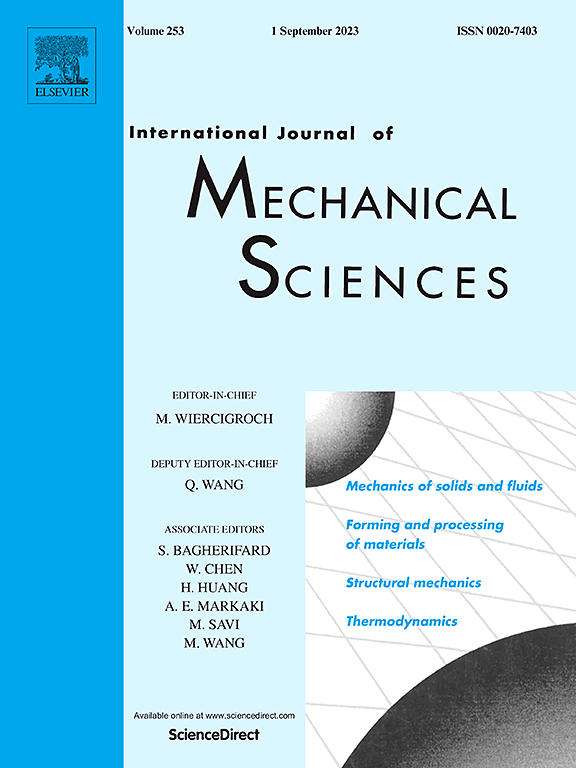Phase-field simulation on grain-size dependent fracture of cyclically loaded NiTi-SMA
IF 9.4
1区 工程技术
Q1 ENGINEERING, MECHANICAL
International Journal of Mechanical Sciences
Pub Date : 2025-02-20
DOI:10.1016/j.ijmecsci.2025.110041
引用次数: 0
Abstract
Based on crystal plasticity theory, a new non-isothermal fracture phase field model was proposed, incorporating various inelastic deformation mechanisms in NiTi shape memory alloy (SMA). The crack propagation of NiTi-SMA under cyclic loading was simulated by addressing its one-way shape memory effect (OWSME) and super-elasticity (SE). The effects of stress-induced martensite transformation (MT), temperature-induced MT, martensite reorientation (MR), and plastic deformation on the crack propagation of NiTi-SMA were examined. The simulated results indicate that dissipation caused by MT, MR, and plastic deformation effectively reduces the crack propagation rate. The fracture mode (crack propagation path) of NiTi-SMA is strongly correlated with the distribution of grain boundaries. As the grain size increases, the crack propagation rate in the super-elastic NiTi systems increases, and the fracture mode gradually transitions from the transgranular fracture to the intergranular one. However, the crack propagation path in the OWSME NiTi system exhibits independence on grain size, and the crack propagation rate within the OWSME system is slightly lower than that in the SE system. The difference of fracture behavior between the super-elastic NiTi system and shape memory NiTi system can be explained from the perspective of microstructure evolution.

循环加载NiTi-SMA晶粒尺寸相关断裂的相场模拟
基于晶体塑性理论,提出了一种新的非等温断裂相场模型,该模型综合了NiTi形状记忆合金(SMA)的多种非弹性变形机制。通过求解NiTi-SMA的单向形状记忆效应(OWSME)和超弹性(SE),模拟了ni - sma在循环加载下的裂纹扩展。研究了应力诱发马氏体相变(MT)、温度诱发马氏体相变(MT)、马氏体重取向(MR)和塑性变形对NiTi-SMA裂纹扩展的影响。模拟结果表明,MT、MR和塑性变形引起的耗散有效地降低了裂纹扩展速率。NiTi-SMA的断裂模式(裂纹扩展路径)与晶界分布密切相关。随着晶粒尺寸的增大,超弹性NiTi体系的裂纹扩展速率增大,断裂模式逐渐从穿晶断裂过渡到沿晶断裂。然而,OWSME - NiTi体系中的裂纹扩展路径与晶粒尺寸无关,OWSME体系中的裂纹扩展速率略低于SE体系。超弹性NiTi体系与形状记忆NiTi体系断裂行为的差异可以从微观组织演化的角度来解释。
本文章由计算机程序翻译,如有差异,请以英文原文为准。
求助全文
约1分钟内获得全文
求助全文
来源期刊

International Journal of Mechanical Sciences
工程技术-工程:机械
CiteScore
12.80
自引率
17.80%
发文量
769
审稿时长
19 days
期刊介绍:
The International Journal of Mechanical Sciences (IJMS) serves as a global platform for the publication and dissemination of original research that contributes to a deeper scientific understanding of the fundamental disciplines within mechanical, civil, and material engineering.
The primary focus of IJMS is to showcase innovative and ground-breaking work that utilizes analytical and computational modeling techniques, such as Finite Element Method (FEM), Boundary Element Method (BEM), and mesh-free methods, among others. These modeling methods are applied to diverse fields including rigid-body mechanics (e.g., dynamics, vibration, stability), structural mechanics, metal forming, advanced materials (e.g., metals, composites, cellular, smart) behavior and applications, impact mechanics, strain localization, and other nonlinear effects (e.g., large deflections, plasticity, fracture).
Additionally, IJMS covers the realms of fluid mechanics (both external and internal flows), tribology, thermodynamics, and materials processing. These subjects collectively form the core of the journal's content.
In summary, IJMS provides a prestigious platform for researchers to present their original contributions, shedding light on analytical and computational modeling methods in various areas of mechanical engineering, as well as exploring the behavior and application of advanced materials, fluid mechanics, thermodynamics, and materials processing.
 求助内容:
求助内容: 应助结果提醒方式:
应助结果提醒方式:


